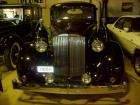|
Re: Differential ratio 1933/1934
|
||||
|---|---|---|---|---|
|
Forum Ambassador

|
Enough has probably been written about this to fill a small book!! I'll bet if you use the search tool you'll find enough just on this forum to fill an hour or two of reading.
Give or take a tenth or two the available ratios were 4.06, 4.35, 4.41, 4.69 and 5.07. Generally the closed cars or heavier bodies got the 4.69 and the lighter bodies got the 4.35 or 4.41 (depending on which chassis). I suppose a buyer could specify any of those available. In 50+ years of following 1934 Eights closely I think I've only encountered a single car (coupe) that had the 4.07. Points to remember include that in 1934 a majority portion of the country's roads were still unpaved, many quite primitive, and roads where the opportunity was presented to cruise at more than 50 mph were similarly somewhat limited; thus those ratios were quite appropriate for the prevailing road conditions and they were the norm among other manufacturers, ratios over 5 were not uncommonly found in inexpensive low-powered cars. These ratios also allowed drivers to go as slow as 5 or 10 mph in high gear and accelerate without need to downshift, that was considered a desireable feature. The problem with these numerically high ratios arises with the desire by many collectors to drive these cars at today's highway speeds, to do so requires engine rpms which are critically high for these very long-stroke motors, even more of a problem for those that also have poured babbit bearings (pre 1935 for Packard). In recent times there was a aftermarket high speed ring and pinion for the Packard Angleset rear made in about 3.98 which worked out very nicely for the Twelves in any body style and the Super Eights in most body styles and the Eights in the lighter body styles. Outside of that, as the tradeoff, the higher speed rears in heavier bodies with the lower hp engines could result in having to downshift to lower gears on modest inclines that you previously climbed with ease in high gear, and lackluster highway acceleration. Thus for many the better answer became to keep the original rear axle ratio and install an overdrive where you could "kickdown" out of OD as needed for hill-climbing, rapid acceleration, etc. Just in my own personal case with my '34 Eight, 5 inch stroke, poured bearings, and a reasonably heavy body (4640 lbs dry weight), I've stayed with the original 4.69 rear axle and have simple decided to avoid roads that require high speeds. In local driving it's quite lively, on highways I rarely exceed 50 mph and even then only for short bursts when essential. And I certainly enjoy driving state and county highways where there is a lot more to be seen and experienced than along Interstates.
Posted on: 2019/1/4 14:56
|
|||
|
||||
|
Re: Differential ratio 1933/1934
|
||||
|---|---|---|---|---|
|
Home away from home

|
Quote:
... A little history lesson would be appreciated here ... Francois (Super8), it could be too late to use the below mentioned service, I'm afraid. How good to have Dave (Owen_Dyneto) aboard. Attach file:  (52.52 KB) (52.52 KB)
Posted on: 2019/1/4 23:17
|
|||
|
The story of ZIS-110, ZIS-115, ZIL-111 & Chaika GAZ-13 on www.guscha.de
|
||||
|
||||
|
Re: Differential ratio 1933/1934
|
||||
|---|---|---|---|---|
|
Quite a regular

|
Thank you for the (very) clear answer to the questions.
Super8
Posted on: 2019/1/5 7:04
|
|||
|
||||








